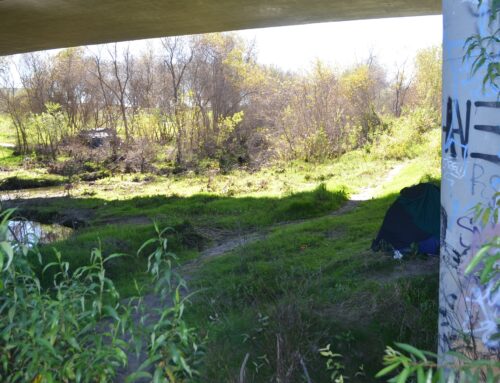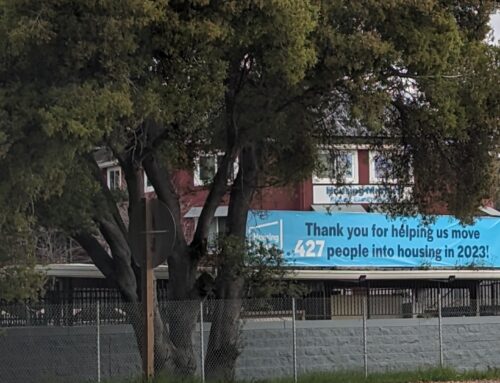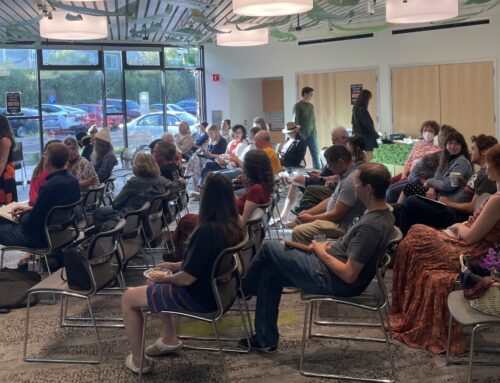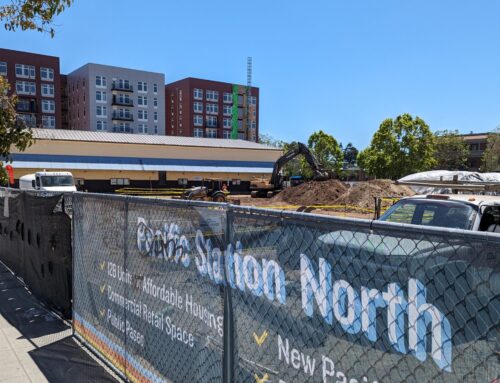SANTA CRUZ >> City officials are in talks with Caltrans and Santa Cruz County staff to relocate a growing camp of unhoused people at Highways 1 and 9 to allow for an intersection widening project that is years in the making.
At Tuesday’s Santa Cruz City Council meeting, city Planning Director Lee Butler updated the council on negotiations with Caltrans, which owns the land along the highway shoulders where many dozens of people have pitched tents. The camp is unmanaged except for city-funded trash pickup five days a week.
Santa Cruz Local offers its news stories free as a public service.
We depend on people like you — we call them our Santa Cruz Local members — to chip in $9 a month or $99 a year to make sure vital information can be available to all. Can we count on your help?
Butler, who now leads the city’s homelessness response efforts, said that city staff have asked Caltrans to provide a place to relocate the campers — either on Caltrans land or other state land. “Conversations are still ongoing,” Butler said.
A meeting is scheduled Thursday with city leaders, county Supervisors Ryan Coonerty and Bruce McPherson, and a Caltrans official who serves on the Santa Cruz County Regional Transportation Commission.
Since the camp is mostly on Caltrans land, state policies dictate that the governor’s office needs to approve any move to clear the camp, Butler said. He added that Caltrans officials have been willing to pursue relocation of the camp due to safety concerns.
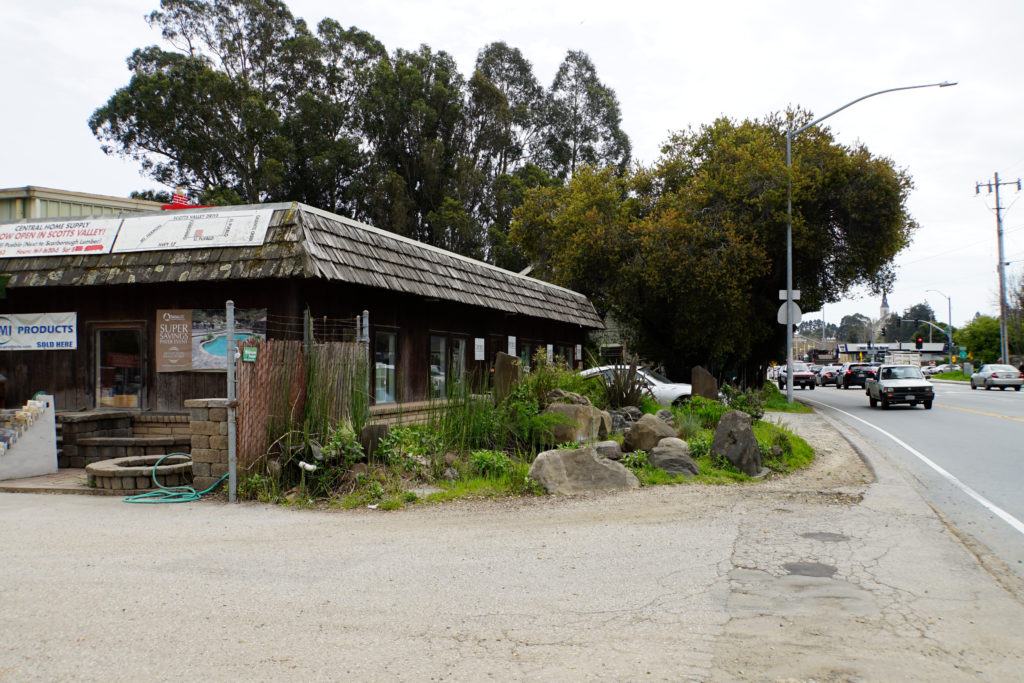
City staff are working with Mayor Donna Meyers to send a letter to the governor this week, to address the camp’s relocation and demand more funding for homelessness response during the pandemic.
“I think our whole community has their eyes on this situation,” Meyers said Tuesday. “And we’re trying to move as fast as possible but we’re definitely hampered by the way the state is looking at the situation. And again, with no real solution on where these folks can go, unfortunately, so we are, in my opinion, caught in the middle in a very bad situation.”
Construction is set to begin in spring on the widening of the intersection of Highways 1 and 9. A $2.8 million grant for the project is set to expire if the city does not begin construction in the next few months. The project would add four lanes to one of the city’s busiest intersections.
Read or listen to Santa Cruz Local’s previous stories on the construction project:
- Santa Cruz council OKs Highway 1 intersection project (May 27, 2020)
- City to use eminent domain (March 26, 2019)
Budget update
As part of a mid-year budget review, the city council unanimously approved the following budget changes:
- A roughly $3.9 million reduction in overall revenue, including a $2 million drop in the city’s General Fund revenue.
- A $5.1 million increase in overall spending, which includes $2.1 million increase to General Fund spending. The largest new expense is a $1.4 million overtime spending request by the city’s fire department, related to statewide emergency response, vacant positions and sick time related to potential COVID exposures, according to the staff report.
- The city’s General Fund is part of the city’s budget that’s funded by taxes, such as sales, property and hotel taxes. The General Fund pays for departments like police, fire, parks and recreation and public works. The General Fund is different from enterprise funds, like water, wastewater and refuse, which are typically self-sustaining through fees.
- Though some city projects and fees raised more money than expected — such as golf course fees — overall revenue was down, largely due to a drop in water use and sales. Expected revenue from water sales is down by nearly $4 million, likely due to COVID restrictions, according to the staff report.
A proposal by city staff to restructure the city manager’s office staff drew some scrutiny from council members, who agreed that the decision should be separate from the mid-year budget update.
City Manager Martín Bernal had proposed to reassign Planning Director Lee Butler to the position of deputy city manager. In recent months, Butler was assigned to lead the city’s homelessness response efforts since the city’s homelessness response manager position became vacant. He has been paid for those services, the equivalent of a $15,000 annual raise. City leaders have struggled to recruit for that position.
With Butler’s move to deputy city manager, Bernal had planned to freeze the planning director and homelessness response manager positions. The deputy city manager position was previously held by Scott Collins, who left the city in 2017. The position since has remained unfunded.
Councilmember Sandy Brown expressed concern that the reinstitution of that position would create another executive-level position during a fiscal crisis. The council ultimately followed Brown’s lead, though for various reasons. Butler was still allowed the raise, but without a new title. In 2019, Butler’s pay was $193,481, according to Transparent California. With benefits it was $253,859, records stated.
Housing approved in Seabright
A controversial three-story, three-unit apartment complex on a lot with a single-family home at 418 Pennsylvania Ave. was approved by a 5-2 vote.
- The lot is zoned for multiple residence-low density, though many neighbors live in single-family homes.
- The units would be rentals. One of the units would be deed-restricted as affordable, based on area median income.
- The city’s Planning Commission approved the project in December in a 4-3 vote. The commission’s approval was appealed by a next-door neighbor and two others who live nearby. The proposal’s “box-shaped structure is out-of-scale and not compatible with the neighborhood,” they wrote in their appeal, and listed other issues. Dozens of neighbors listed similar concerns to the city council and planning commission. Several residents — many of whom cited difficulty finding rentals in the city — advocated for the project.
Planning Director Lee Butler said the issue boiled down to SB330, a state law that limits cities’ ability to block housing projects. The law states that the city’s standards must be applied to allow development at the density allowed by the city’s General Plan and proposed by the developer.
That law also prevents city leaders from recommending a redesign that would result in less square footage or fewer bedrooms. City staff had discussed design changes including a sloped roof, but ultimately state law prevented city leaders from requiring that change because it would reduce density, Butler said.
Councilmembers Justin Cummings and Sandy Brown voted against the project. Cummings and Brown wanted the council to delay action and give the neighbors and developer another chance to reconcile their differences. Cummings said he worried about a possible lawsuit from both sides.
Possible water restrictions
With winter rainfall in Santa Cruz below average so far, and the total runoff of the city’s largest water source — the San Lorenzo River — still classified as “critically dry,” Santa Cruz Water Director Rosemary Menard said Tuesday that summer water restrictions may be possible.
Menard gave an update on the city’s water supply outlook, but the council made no decisions Tuesday.
Menard said her staff would monitor supply, and if necessary, in April propose water use restrictions that would take effect in June. However, she added that in recent years water demand has been down at an “efficient” level, so the effect of restrictions could be limited. Menard said at the council’s Feb. 23 meeting, she plans to propose a “major rewrite” of the city’s water shortage contingency plan to reflect current demand.
Editor’s note: This story has been updated to clarify that Butler had already received the equivalent of a $15,000 annual raise before the council’s vote Tuesday.
Kara Meyberg Guzman is the CEO and co-founder of Santa Cruz Local. Prior to Santa Cruz Local, she served as the Santa Cruz Sentinel’s managing editor. She has a biology degree from Stanford University and lives in Santa Cruz.


